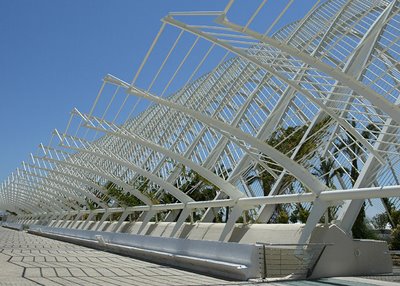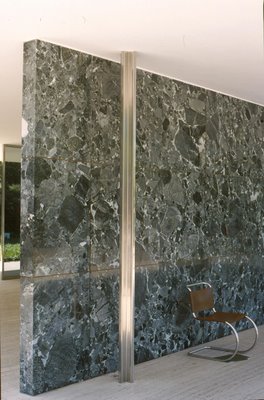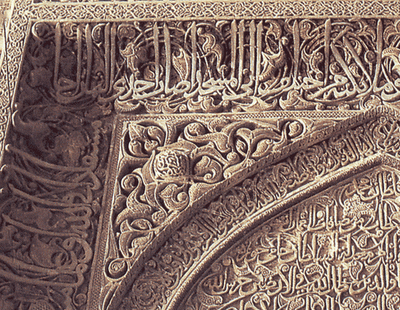Ornament in Architecture
"...I beg you in the interim to reflect that this godlike human body has no ornament."
One of my favorite quotes regarding ornament. In a letter to Ralph Waldo Emerson, Horatio Greenough here embodies the soul of the Transcendentalists movement and their ideal of organic beauty, nature as truth, and truth as beauty.
Modern Ornament?

Here's a topic that can take up a bit more space than a single blog entry, atleast 200 years worth of philosophy and architectural history and it still goes much further back than that. The Temple of Hera II, for example, was a purely functional building with no ornament; a simple assembly hall meant to serve the needs of the local populance. The friezes of these Greek temples at Paestum, which one envisions covered with gods, goddesses and horses (am I wrong?), are not believed to have been ordained with their relief sculptures until years after their construction. Much in the same manner, medieval architecture was often "rebuilt" during the Renaissance with the only real change being a small expansion and widespread additional ornamentation.
Material Beauty as Ornament?

Now that we have well emerged from the era of Miesian Modernism we as architects have once again begun to explore the ornamental realm without being overwhelmingly criticized and the influx of digital technology gives us the opportunity to engineer just about anything we can visually imagine, just ask Libeskind or Gehry.
Functional Ornament?

But is it necessary to abandon traditionally rational structure just because we have the capability (though not always the finances)? It seems that more and more often I feel that the starchitects of our time have sold their souls for a place on the pedestal and brutalism has been revived with a more angular, curvilinear, and successful attitude than before. I see these sculptural forms as ornament in themselves. On the other hand, the interior of a building can be dressed in a luxurious manner by using high quality and often pricey materials and still have no ornament according to Loosian standards. I think our modern path in architecture places ornament on larger, very different scale than the detailing of Frank Lloyd Wright or that found in the Greek orders.
Ornament as Indigenous Identity?

You might want to check out these links regarding the history of ornament and some modern discussions of what it now means.
Architectural Ornament history
The New Iconic Building? - Charles Jencks & Peter Eisenmen
podcast - "Architecture Parlante: The Grammar of Ornament and Crime and Punishment"
http://www.tyznik.com/ap/ap.rss (iTunes--"Advanced"--"Subscribe to Podcast"--then paste this link)
One of my favorite quotes regarding ornament. In a letter to Ralph Waldo Emerson, Horatio Greenough here embodies the soul of the Transcendentalists movement and their ideal of organic beauty, nature as truth, and truth as beauty.
Modern Ornament?

Here's a topic that can take up a bit more space than a single blog entry, atleast 200 years worth of philosophy and architectural history and it still goes much further back than that. The Temple of Hera II, for example, was a purely functional building with no ornament; a simple assembly hall meant to serve the needs of the local populance. The friezes of these Greek temples at Paestum, which one envisions covered with gods, goddesses and horses (am I wrong?), are not believed to have been ordained with their relief sculptures until years after their construction. Much in the same manner, medieval architecture was often "rebuilt" during the Renaissance with the only real change being a small expansion and widespread additional ornamentation.
Material Beauty as Ornament?

Now that we have well emerged from the era of Miesian Modernism we as architects have once again begun to explore the ornamental realm without being overwhelmingly criticized and the influx of digital technology gives us the opportunity to engineer just about anything we can visually imagine, just ask Libeskind or Gehry.
Functional Ornament?

But is it necessary to abandon traditionally rational structure just because we have the capability (though not always the finances)? It seems that more and more often I feel that the starchitects of our time have sold their souls for a place on the pedestal and brutalism has been revived with a more angular, curvilinear, and successful attitude than before. I see these sculptural forms as ornament in themselves. On the other hand, the interior of a building can be dressed in a luxurious manner by using high quality and often pricey materials and still have no ornament according to Loosian standards. I think our modern path in architecture places ornament on larger, very different scale than the detailing of Frank Lloyd Wright or that found in the Greek orders.
Ornament as Indigenous Identity?

You might want to check out these links regarding the history of ornament and some modern discussions of what it now means.
Architectural Ornament history
The New Iconic Building? - Charles Jencks & Peter Eisenmen
podcast - "Architecture Parlante: The Grammar of Ornament and Crime and Punishment"
http://www.tyznik.com/ap/ap.rss (iTunes--"Advanced"--"Subscribe to Podcast"--then paste this link)

0 Comments:
Post a Comment
<< Home